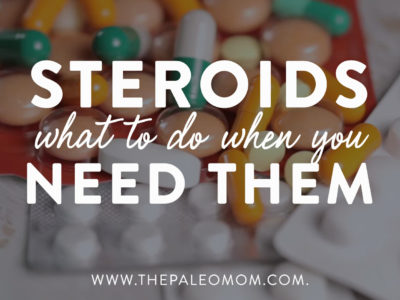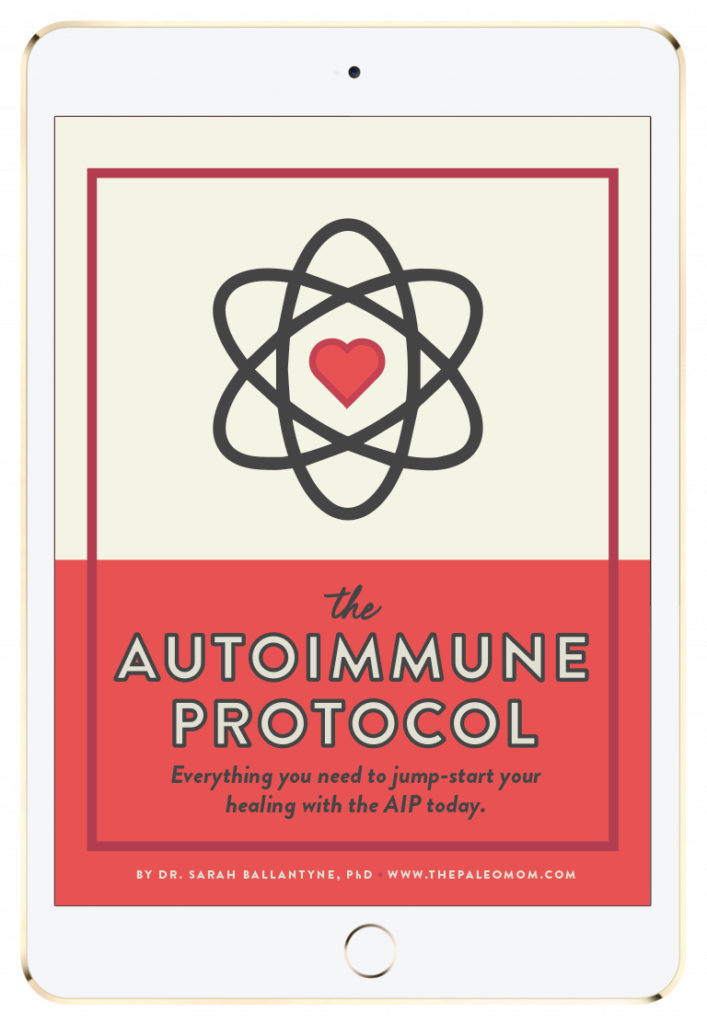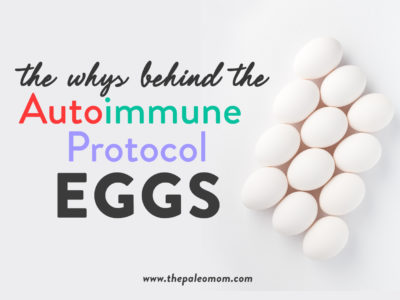Corticosteroids are man-made hormones similar to the cortisol naturally produced by our adrenal glands, typically prescribed for autoimmune conditions and inflammatory disorders. (Even though they’re often just called “steroids,” corticosteroids are not the same as anabolic steroids some people use as performance-enhancing drugs!) Out of all the medications we could potentially take, steroids have some of the greatest potential for serious side effects and long-term harm. So, we definitely shouldn’t take these drugs if we don’t need to!
Table of Contents[Hide][Show]
But, as with antibiotics, there are times when steroids can be extremely helpful (including for autoimmune conditions), and potentially even save our lives. We shouldn’t feel bad or guilty if we find ourselves in a situation where using them is the best course of action. Understanding what steroids do and how to counteract their side effects can help us minimize the problems they’re associated with!
What Are Corticosteroids and How Do They Work?
 In our bodies, the adrenal cortex produces a class of steroid hormones (corticosteroids) that play a role in stress response, immune regulation, electrolyte regulation, carbohydrate metabolism, protein catabolism, and even our behavior (see Demystifying Adrenal Fatigue, Pt. 1: What Is Adrenal Fatigue? and How Stress Undermines Health). Corticosteroid drugs (like prednisone and hydrocortisone) are synthetic versions of these hormones, and are used to suppress inflammation and immunity for certain health conditions—including asthma, lupus, inflammatory bowel disease, multiple sclerosis, rheumatoid arthritis, eczema, and other problems that involve excessive immune activity or inflammatory response.
In our bodies, the adrenal cortex produces a class of steroid hormones (corticosteroids) that play a role in stress response, immune regulation, electrolyte regulation, carbohydrate metabolism, protein catabolism, and even our behavior (see Demystifying Adrenal Fatigue, Pt. 1: What Is Adrenal Fatigue? and How Stress Undermines Health). Corticosteroid drugs (like prednisone and hydrocortisone) are synthetic versions of these hormones, and are used to suppress inflammation and immunity for certain health conditions—including asthma, lupus, inflammatory bowel disease, multiple sclerosis, rheumatoid arthritis, eczema, and other problems that involve excessive immune activity or inflammatory response.
Steroids can either be delivered locally (eye drops, ear drops, skin creams, or joint injections) or systemically (oral medications or intravenous injections that spread the medication throughout the whole body). While steroids can be prescribed at a variety of doses (from 5mg to 100mg for oral), and anywhere from a short-term intervention (3 to 21 days) to a daily long-term medication, in general, it’s the long-term, systemic ingestion of steroids that brings the most potential for harm.
Corticosteroid drugs work by binding to glucocorticoid receptors in immune cells, signaling the resolution of inflammation and immunity. However, they also flood the body with glucocorticoids (i.e., cortisol), with similar ramifications to intense chronic stress, and typically with no heed to the need for fluctuations in levels throughout the day (although this is why taking prednisone in the morning often minimizes side effects, see Regulating Circadian Rhythm (and why that’s important)), which causes a further increase in glucocorticoid-receptor resistance. This is why a course of steroids typically involves tapering the dose and why symptoms can return (sometimes with a vengeance) after a course of steroids is completed. Steroids also compromise the immune system, contribute to a leaky gut, and hinder the normal healing process. Ugh!
Corticosteroid drugs can be lifesaving though (although they are also commonly prescribed for symptom relief). Most people dislike taking steroids because of the intense side effects, like appetite stimulation, cravings for calorie-dense foods, weight gain, low energy, restlessness, and trouble sleeping. As you can imagine, these side effects themselves have consequences for the immune system. Corticosteroids are frequently prescribed for autoimmune disease patients during a flare to help suppress the immune system, but patients often find that once they start taking steroids, it’s very difficult to stop. This is because once you discontinue them, the immune system is no longer inhibited but the body is even more cortisol-receptor-resistant than it was before. In fact, for some autoimmune diseases, steroids are contraindicated because of the rebound effects after stopping a course of them.
When Are Corticosteroids Needed?
Despite the risks, there are definitely some circumstances where taking steroids is the best option—namely when our bodies aren’t adequately regulating inflammation and immunity. During an autoimmune flare-up, it might be worth it to use steroids to get symptoms under control, especially if those symptoms are dangerous or debilitating! In some cases of lupus, for example, corticosteroids can help reduce kidney inflammation that would otherwise lead to kidney failure. Or, a rheumatoid arthritis patient might find relief from extreme pain and stiffness (which interfere with daily functioning) by taking steroids. In general, the pros start outweighing the cons when the disease is severe enough to cause physical damage, inhibit normal living, become life-threatening, or when there are no other adequate treatment options.
 So, while there are definitely some undesirable effects caused by corticosteroids, there is definitely a time and a place for these medications (I’ve personally had to take them 6 times in my life, twice since going Paleo 5.5 years ago, once for a massive allergic reaction to a medication prescribed after I suffered a 3rd-degree burn and one for pneumonia). If that’s you, remember that medication is not failure but rather an incredibly useful tool that we can avail ourselves of when the time is right. Of course, when we do hit the steroid-requiring crisis points, these are also opportunities to evaluate our choices and learn whether or not we can make improvements to better regulate our immune systems (see The Autoimmune Protocol). And, when you are faced with a course of corticosteroids, you’ll definitely want to work to mitigate side effects and nutritional deficiencies.
So, while there are definitely some undesirable effects caused by corticosteroids, there is definitely a time and a place for these medications (I’ve personally had to take them 6 times in my life, twice since going Paleo 5.5 years ago, once for a massive allergic reaction to a medication prescribed after I suffered a 3rd-degree burn and one for pneumonia). If that’s you, remember that medication is not failure but rather an incredibly useful tool that we can avail ourselves of when the time is right. Of course, when we do hit the steroid-requiring crisis points, these are also opportunities to evaluate our choices and learn whether or not we can make improvements to better regulate our immune systems (see The Autoimmune Protocol). And, when you are faced with a course of corticosteroids, you’ll definitely want to work to mitigate side effects and nutritional deficiencies.
 What Are the Side Effects?
What Are the Side Effects?
Although there aren’t usually severe side effects from using steroids short-term and in low doses, the risk goes up substantially the longer they’re taken and the higher the dosage. And, children and the elderly are more likely to experience side effects than the rest of the population. Some of the problems corticosteroids can cause include:
- Acne
- Osteoporosis
- High blood pressure due to sodium retention
- Increased appetite (and unwanted weight gain as a result!)
- Mood swings
- Poor wound healing
- Increased risk of infection
- Metabolic disturbances
- Redistribution of body fat to the face and torso
- Hyperglycemia and diabetes
- Glaucoma
- Cataracts
- Depression
- Other central nervous system effects (agitation, insomnia, decreased concentration, poor memory, anxiety)
- Easy bruising
- Withdrawal symptoms (due to the suppression of the adrenal glands)
Beyond that, corticosteroids can be a double-edged sword when it comes to gut health! On one hand, these medications help reduce the inflammation associated with certain bowel diseases (like Crohn’s disease and ulcerative colitis), and are commonly prescribed to treat flare-ups. But, long-term use of steroids can actually loosen the gut barrier and result in changes to the microbiome that encourage pathogenic bacteria to flourish. So, while these drugs do help manage acute symptoms, over time, they can actually worsen some of conditions they’re being used for (as well as damage gut health in general).
Save 70% Off the AIP Lecture Series!
Learn everything you need to know about the Autoimmune Protocol to regain your health!
I am loving this AIP course and all the information I am receiving. The amount of work you have put into this is amazing and greatly, GREATLY, appreciated. Thank you so much. Taking this course gives me the knowledge I need to understand why my body is doing what it is doing and reinforces my determination to continue along this dietary path to heal it. Invaluable!
Carmen Maier
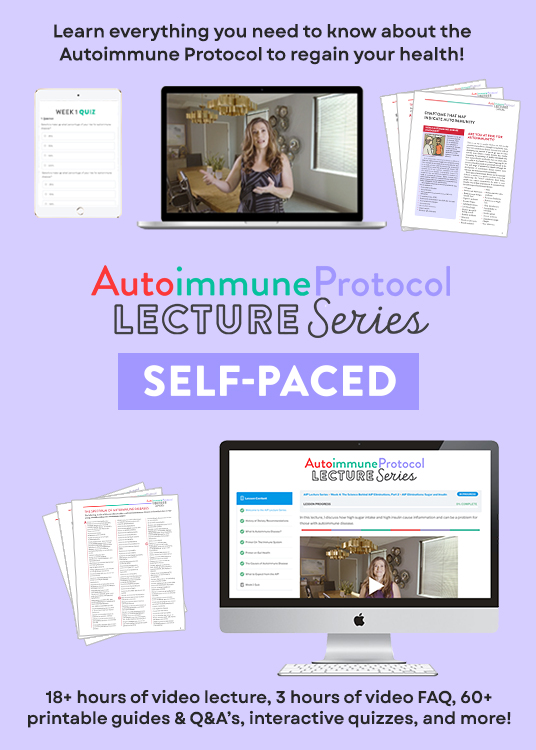
Nutrients Depleted by Corticosteroids
Corticosteroids can deplete levels of several important nutrients in the body–vitamin B6, vitamin C , copper, magnesium, potassium, selenium, and zinc–a few of these that are key players in immune health. Because corticosteroids are typically prescribed when immune systems are overactive (as in an autoimmune flare or severe allergic reaction), supporting immune health via nutrition becomes especially important. In fact, several nutrient deficiencies are known to cause inflammation and one of the best strategies for mitigating inflammation is nutrient sufficiency (discussed at length in The Paleo Approach). In addition, cortocosteroids is known to impair calcium absorption and bone formation, dramatically increasing rates of osteoporosis with long-term use, so a focus on calcium, vitamin D, and vitamin K2 is also important. Supplementation or specific focus on food sources of these nutrients can be absolutely vital to both mitigating side effects (see more on that below) and to recovery from corticosteroid use.
The following nutrients are depleted or impaired by corticosteroid use.
 Vitamin B6
Vitamin B6
Important for cell metabolism and the production of hemoglobin, which carries oxygen in the blood. It’s also vital for producing the key neurotransmitters GABA, dopamine, and serotonin. Sources include a wide variety of plant and animal foods, including leafy and root vegetables, fruit such as bananas, red meat, poultry, and seeds (especially sunflower and pumpkin).
 Vitamin C
Vitamin C
A potent antioxidant that’s necessary for immune system function and the function of several enzymes (like some that help make collagen, which is why vitamin C deficiency causes scurvy). Foods rich in vitamin C include citrus fruits, bell peppers, leafy dark green vegetables, and other fruits such as papaya, cantaloupe, guava, and berries. Some organ meats are also good sources of vitamin C.
 Vitamin D
Vitamin D
A fat-soluble vitamin that assists in calcium absorption, immune system function, bone development, modulation of cell growth, neuromuscular function, and the reduction of inflammation. Although vitamin D can be produced when the sun’s UV rays hit the skin and trigger vitamin D synthesis, it can also be obtained from foods, including oily fish (such as salmon, tuna, and mackerel), mushrooms, fish roe, liver, and eggs.
 Vitamin K
Vitamin K
Central to maintaining bone health and critical for making important proteins in the body that are involved in blood clotting and metabolism (in fact, that’s where the “K” comes from—the German word for blood clotting, koagulation). Vitamin K exists in the forms of K1, K2, and K3, and, in the form of K2, boosts cardiovascular health. The richest sources of vitamin K include cruciferous vegetables (such as broccoli, cauliflower, cabbage, and Brussels sprouts) and leafy dark green vegetables (such as spinach, collard greens, parsley, and Swiss chard), as well as asparagus. Vitamin K2, specifically, is found in eggs, grass-fed butter, and liver. Some vitamin K2 is also produced by our gut bacteria from dietary vitamin K1.
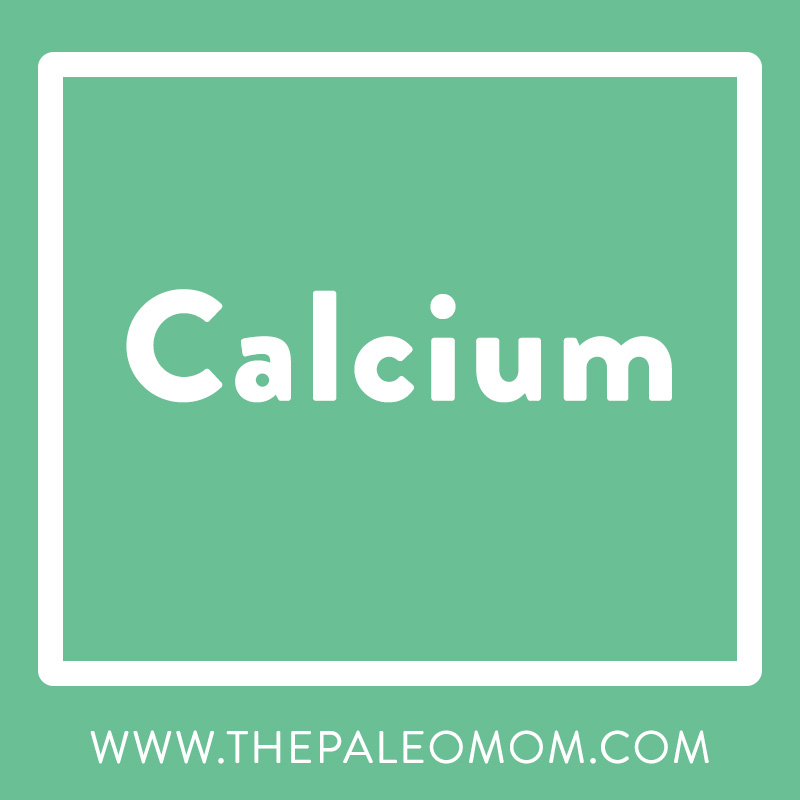 Calcium
Calcium
In addition to forming bone, calcium is essential to many processes within cells, as well as neurotransmitter release and muscle contraction (including the beating of your heart!). Foods rich in calcium include dark green vegetables, whole sesame seeds, dairy products, whole sardines (bones included), and squash.
 Copper
Copper
Involved in the absorption, storage, and metabolism of iron and the formation of red blood cells. It’s also important for building strong tissue and producing cellular energy. Excellent sources include oysters and other shellfish, nuts, organ meat, and mushrooms.
M agnesium
agnesium
Necessary for cell life. More than 300 different enzymes need magnesium to work, including every enzyme that uses or synthesizes ATP (the basic energy molecule in a cell) and enzymes that synthesize DNA and RNA. It also enhances control of inflammation and maintains nervous system balance. Foods rich in magnesium include green vegetables, nuts and seeds, fish, and avocados.
 Potassium
Potassium
Critical for the function of every cell; it is necessary for nerve function, cardiac function, and muscle contraction. As an electrolyte, it helps conduct electrical charges in the body. Rich sources include leafy dark green vegetables, cruciferous vegetables, some fruit (such as bananas and cantaloupe), and many orange vegetables (such as carrots, squash, and sweet potatoes).
S elenium
elenium
Required for the activity of 25 to 30 different enzymes that protect the brain and other tissues from oxidative damage. It also helps support normal thyroid function. Good sources include red meat, poultry, fish and shellfish, Brazil nuts, and mushrooms.
 Zinc
Zinc
Important for nearly every cellular function, from protein and carbohydrate metabolism to cell division and growth. It also plays a role in skin health and maintaining sensory organs (that’s why zinc deficiency is associated with loss of smell and taste) and is a vital nutrient for immune system function. The richest source of zinc is oysters, but other good sources include red meat, poultry, nuts and seeds.
 How To Mitigate Steroid Side Effects
How To Mitigate Steroid Side Effects
If we reach a point where taking steroids is necessary (and that’s okay if that’s the case!), there are a few things we can do to help limit or manage the potential side effects (both during usage and afterward!). Those include:
Manage stress!
Because of the effect of corticosteroids on the adrenal glands, our ability to respond to physical and psychological stress can decrease dramatically (an effect that can last up to a year after we’ve stopped taking the medication). That makes it extra important to engage in activities that improve our stress resilience (like yoga, meditation, massage, social bonding, gentle walking, and laughing), as well as saying “no” when we need to or asking for help when we’re feeling overwhelmed.
Sleep a lot!
Not only is getting enough sleep a huge component of stress management, it also helps promote better healing and immunity (which can be compromised when taking steroids). Due to the tendency for steroids to affect sleep and cause insomnia, it’s vital to give ourselves plenty of time to drift off, as well as spend longer in bed in order to compensate for any nighttime wakeups or restlessness we might experience.
Don’t caffeinate!
Caffeine causes an exaggerated cortisol release (especially in response to stress), which is exactly what we don’t want when we’ve been taking medications that suppress our natural cortisol production.
Alternate medication days!
In some cases, taking steroid doses every other day (instead of daily) can help significantly reduce the side effects. This option varies on an individual basis (depending on the type and severity of the condition) and is best discussed with a physician.
Supplement!
Vitamin B6, vitamin C, vitamin D, vitamin K2, calcium, copper, potassium, magnesium, selenium and zinc can help support immune function and bone health, protecting against the potential side effect of decreased bone density and osteoporosis. Eating foods rich in these nutrients is also a great idea (dark leafy greens, citrus, fish, shellfish and organ meats fit the bill!).
Load up on seafood!
Some research suggests that omega-3 fatty acids can help reduce cortisol secretion in response to stress, while omega-3 deficiency exaggerates the stress response. Again, with steroids directly affecting the adrenal glands, stabilizing our stress response is a high priority. The solution? Enjoy some oily fish!
Eat sufficient protein!
Corticosteroids can influence protein metabolism, making it important to get enough in our diet. (Thanks to protein’s effect on satiety and thermogenesis, eating plenty of protein can also help counteract the increased appetite and weight gain associated with steroid use.)
Dose in the morning!
When possible, taking the entire steroid dose in the morning can help prevent insomnia.
Taper!
During sustained use of corticosteroids, the adrenal glands slow down or stop their normal production of cortisol. So, if we try to quit steroids cold-turkey after our bodies have adjusted to them (usually after two weeks of usage), the withdrawal symptoms can be pretty unpleasant (muscle stiffness, fever, tenderness, fatigue, and pain are common). For that reason, it’s important to gradually reduce the dosage instead of stopping all at once! The best rate of tapering will depend on the original dosage, the specific medication, how long it was taken for, and the disease being treated. But, a ballpark is to decrease the dosage by the equivalent of 2.5 to 5 mg of prednisone every 3 to 7 days, until the dose reaches 5 mg of prednisone (or equivalent) per day. In general, it can take anywhere from a week to a few months to fully taper off most corticosteroids, and the after-effects can last up to a year. Always consult your healthcare provider before altering medications or supplements!
Summing it Up
Although the idea of taking steroids can be scary (especially after seeing that long list of side effects!), severe health conditions sometimes make them necessary. If we support our health with a nutrient-dense Paleo diet, and follow the specific diet and lifestyle ideas discussed above, we can increase the odds of using these medications without serious side effects!
Citations
Atkinson SA, et al. “Bone and mineral abnormalities in childhood acute lymphoblastic leukemia–influence of disease, drugs, and nutrition“, Int J Cancer Suppl, 1998, 11:35-9.
Barbadoro P, et al. “Fish oil supplementation reduces cortisol basal levels and perceived stress: a randomized, placebo-controlled trial in abstinent alcoholics.” Mol Nutr Food Res. 2013;57(6):1110-4
Chesney RW et al. “Reduction of serum-1,25-dihydroxyvitamin-D, in children receiving glucocorticoids“. Lancet 1978;ii:1123-25.
Ciriaco M, et al. “Corticosteroid-related central nervous system side effects.” J Pharmacol Pharmacother. 2013 Dec; 4(Suppl1): S94–S98.
Fodor L, et al. “Studies on the glucocorticoid control of zinc metabolism“, Infusionsther Klin Ernahr, 1975, 2(3):210-3.
Frequin ST, et al. “Decreased vitamin B12 and folate levels in cerebrospinal fluid and serum of multiple sclerosis s after high-dose intravenous methylprednisone“, J Neurol, 1993, 240(5):305-8.
Gianotti L, et al. “Steroid therapy can modulate gut barrier function, host defense, and survival in thermally injured mice.” J Surg Res. 1996 Apr;62(1):53-8.
Gol’berg ED, et al. “The effect of immunosuppressive substances on the zinc content in cells“, Biull Eksp Biol Med, 1993, 116(10):412-3.
Mowat C, et al. “Guidelines for the management of inflammatory bowel disease in adults.” Gut. 2011 May;60(5):571-607.
Peretz A, et al. “Selenium status in relation to clinical variables and corticosteroid treatment in rheumatoid arthritis“, J Rheumatol, 1987, 14(6):1104-7.
Probert C. “Steroids and 5-aminosalicylic acids in moderate ulcerative colitis: addressing the dilemma.” Therap Adv Gastroenterol. 2013 Jan; 6(1): 33–38.
Schäcke H, et al. “Mechanisms involved in the side effects of glucocorticoids.” Pharmacol Ther. 2002 Oct;96(1):23-43.
Simeckova A, et al. “Effect of prednisolone on the rat bone calcium, phosphorus, and magnesium concentration“, Physiol Bohemoslov, 1985, 34(2):155-60.
Shenfield GM, et al. “Potassium supplements in patients treated with corticosteroids“, Br J Dis chest, 1975, 69:171-6.
Stanbury RM & Graham EM. “Systemic corticosteroid therapy—side effects and their management.” Br J Ophthalmol. 1998;82:704-708.
Widmer P, et al: “Diuretic-Related hypokalaemia–the role of diuretics, potassium supplements, glucocorticoids, and beta-2-adrenoceptor agonists–results from the Comprehensive Hospital Drug Monitoring program“, Berne (CHDM), Eur J Clin Pharmacol, 1995, 49(1-2): 31-6.
Yunice AA, et al. “Influence of synthetic corticosteroids on plasma zinc and copper levels in humans“, Am J Med Sci, 1981, 282(2):68-74.

